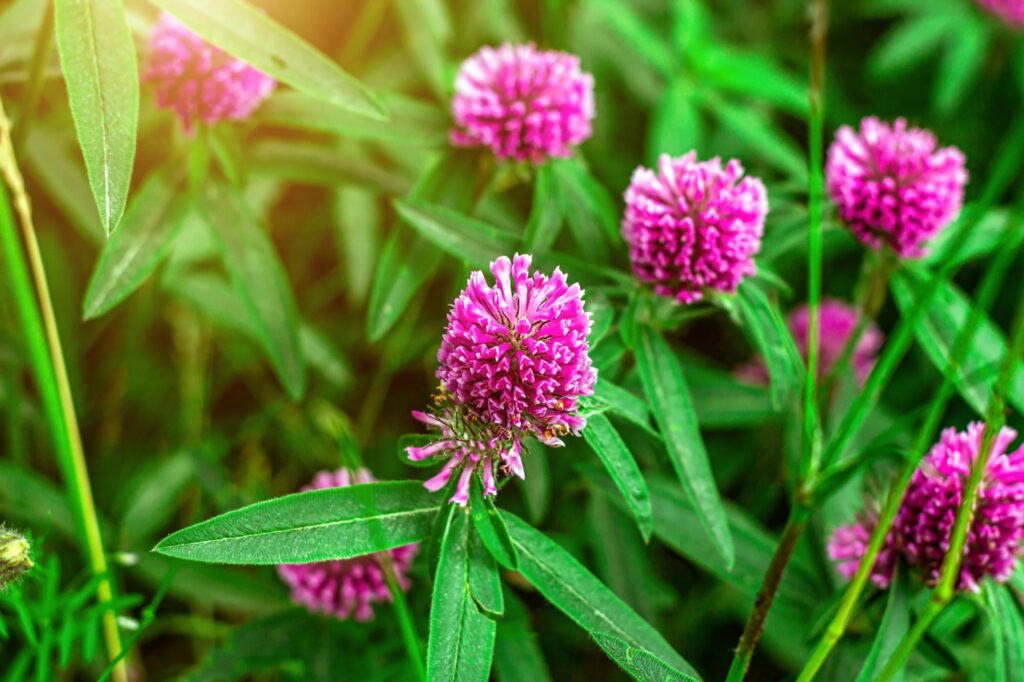
1. If you have bare earth around your house and do not yet know what to do with it, plant red or pink clover, whose seeds are widely available through Internet vendors, until you make a decision. The symbiotic bacteria that live in symbiosis with clover roots manufacture nitrate that enhances soil fertility. Meanwhile, clover aerates the soil with its penetrating roots and helps to keep pathogenic soil fungi at bay. To enhance soil fertility in your vegetable garden, plant clover once your tomato, pepper, cucumber, and corn plants have established themselves. You can broadcast the clover seed in between the developing crops or even underneath their foliage. After you have harvested your edibles, allow the clover to continue growing as an intermediate crop. Three weeks before planting your fall or winter vegetable garden, cut the clover plants down and work them into the soil.
2. If you take a fancy to variegated foliage that is pink, green, and cream-colored, you might want to consider ornamental Japonica striped maize. This variety originated in Japan over a hundred years ago but has only recently been brought into the regular nursery trade. It produces edible, burgundy-colored corn. There is also strawberry popcorn which yields two- to three-inch-long ruby ears shaped like elongated strawberries, although the popped kernels are white. As long as we are on the subject of colorful cereal grasses, you might consider planting Utrecht blue wheat as well. Its seed heads are a vivid blue and not only add interest to the garden, but endure in dry flower arrangements for many months. You can find seeds of these corn and wheat varieties, as well as seeds of many other exotic heirloom plants, edible and otherwise, at rareseeds.com.
3. Now that spring planting is in full gear, Monrovia Nursery has a free feature on its website that allows you to learn which annuals, perennials, shrubs, conifers, trees, bamboos, succulents, vines, and edibles suited to your locale. Go to monrovia.com and click on “plant finder” at the top of the page. You will be taken to a box where you enter your zip code. Upon doing so, you will become privy to the wealth of plants appropriate for your climate zone. When it comes to garden selections, we tend to limit ourselves and it’s a real eye-opener when we see the plethora of botanical possibilities available to us. I was pleasantly surprised to discover several blueberry varieties suitable for growing in my zone 10 (according to the USDA climate map) location; these included Bountiful Blue, which received glowing reviews from satisfied customers such as Jessica, who said her bushes “have been happy and healthy in large containers. They have produced so many delicious berries that we have a hard time keeping up with them, and that’s coming from a family with young children that constantly go outside and graze off them.”
4. Benefit from umbellifers, a family of plants known for their lacey foliage and herbal qualities, including dill, fennel, parsley, and cilantro. They not only enhance your spice cabinet but attract a wide variety of beneficial insects as well, especially if you let them flower. Carrots are the most famous umbellifer crop and you can plant them throughout the garden for both ornamental and instant snacking purposes. You can order heirloom carrot varieties from seedsavers.com, including the purple-skinned ‘Dragon’ and the squat ‘Paris Market’ that grows in “shallow, rocky soil.” Mustard and arugula, on account of their abundant pollen and nectar once they flower, are also highly recommended for bringing in beneficial insects.
Related Articles
How to thin fruit from your trees and why you need to do this
What you need to know about growing plants in a container garden
Cutting, pruning, planting: 5 things to do in the garden this week
How to keep pets safe in the garden
Gardening tips: Want kids to love working in the garden? Try these strategies
5. Start potatoes from seed potatoes – the trade name for potatoes especially selected to grow more potatoes – by mail order or plant your own store-bought potatoes once their eyes begin to sprout. Cut your sprouted potatoes into plantable pieces, making sure there is it at least one sprout per piece. Let your potatoes “seal” for a couple of days prior to planting after you cut them into pieces. Dig a trench eight inches deep in soft, perfectly drained soil, and place your potato pieces in it, with the eyes facing up, twelve inches apart. Cover the pieces with some soil. As shoots start to grow, bring soil around the stems. Continue covering the stems as the plants increase in size, eventually filling the trench. When potatoes start to flower, you can uncover the stems and begin harvesting potatoes, a few at a time. Once the leaves begin to turn brown, harvest all the remaining potatoes. If you have grown potatoes successfully, please send me your story by email.
Please send questions, comments, and photos to Joshua@perfectplants.com. Access photos of plants and flowers on Instagram via thesmartergardener1.
